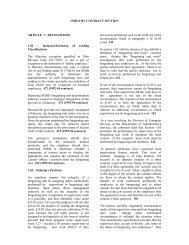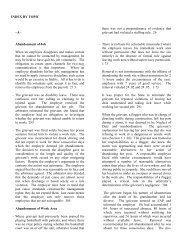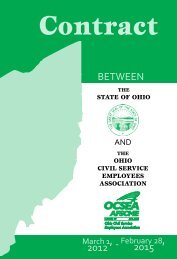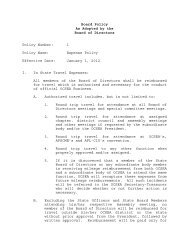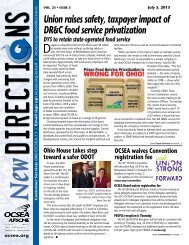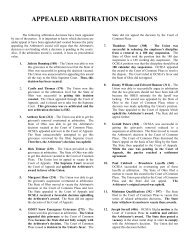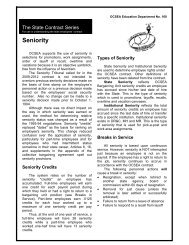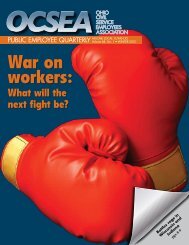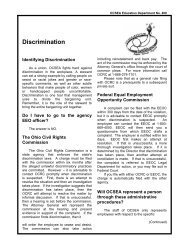OCSEA -- A Brief History
OCSEA -- A Brief History
OCSEA -- A Brief History
Create successful ePaper yourself
Turn your PDF publications into a flip-book with our unique Google optimized e-Paper software.
<strong>OCSEA</strong> Education Department No. 303<br />
<strong>OCSEA</strong> -- A <strong>Brief</strong> <strong>History</strong><br />
The Ohio Civil Service Employees<br />
Association was formed on April 15, 1938,<br />
by James Bowman, a Department of Liquor<br />
Control employee from Cleveland, who lost<br />
his job for political reasons. Frustrated by<br />
the lack of rights, protections, compensation<br />
and benefits for public workers, Bowman<br />
sought to eliminate the "spoils" system<br />
where politics dominated hiring. He wanted<br />
to foster the careers of Ohio public<br />
employees, and he dreamed of an<br />
organization that would fight for state<br />
employees' rights.<br />
Early victories<br />
Bowman tragically died shortly after<br />
establishing <strong>OCSEA</strong>, but others quickly<br />
filled his shoes and turned <strong>OCSEA</strong> into an<br />
effective organization that has been behind<br />
nearly every pay raise, benefit improvement<br />
and retirement increase in the last five<br />
decades.<br />
In 1943, <strong>OCSEA</strong> won the first acrossthe-board<br />
pay increase for state employees,<br />
resulting in a 10% raise. In 1947, <strong>OCSEA</strong><br />
conducted the first broad study on<br />
employee classifications, job descriptions<br />
and salary schedules. The result was the<br />
first comprehensive list of public employee<br />
jobs and the creation of uniform pay<br />
schedules, the latter ending pay differences<br />
in similar jobs that were as large as 210%.<br />
A major <strong>OCSEA</strong> undertaking involved<br />
the 40-hour work week. In 1941, hospital<br />
aides were working 72 hours a week.<br />
Although "female labor laws" that were on<br />
the books during those years stated that a<br />
woman couldn't work more than 48 hours a<br />
week, the state managers routinely violated<br />
this rule. Finally, in 1955, <strong>OCSEA</strong> helped to<br />
pass a law that for the first time gave<br />
public<br />
employees the<br />
right to a 40-hour work week.<br />
Membership<br />
Records show that a few months after<br />
<strong>OCSEA</strong>'s start, 150 members were paying<br />
$1.00 annual dues. In 1944, <strong>OCSEA</strong><br />
crossed the threshold of having over 5,000<br />
members for the first time. In 1947,<br />
<strong>OCSEA</strong>'s 10,000 members made it the<br />
second largest public employees union in<br />
the United States.<br />
By 1975, <strong>OCSEA</strong> had 26,000<br />
members, but membership leveled off as<br />
<strong>OCSEA</strong> faced increased competition from<br />
rival unions and employee organizations.<br />
After affiliation with AFSCME and<br />
subsequent victories in state bargaining unit<br />
elections, <strong>OCSEA</strong> membership grew to<br />
38,000.<br />
Collective Bargaining<br />
In the early years, <strong>OCSEA</strong> leaders<br />
became frustrated by the legal battles,<br />
needed in the civil service fight. Legislative<br />
changes were just as frustrating because<br />
pay raises and employee policies could be<br />
reversed by a simple re-vote or change in<br />
administration.<br />
In the 1960's, <strong>OCSEA</strong> began looking<br />
seriously at collective bargaining as a<br />
solution. Slowly, <strong>OCSEA</strong> gained membersonly<br />
contracts for employees in a number of<br />
departments such as ODOT, MH and MR.<br />
But even these contracts were of limited<br />
scope. The demand for full-scale public<br />
employee collective bargaining grew.<br />
first collective bargaining legislative<br />
(Continued)
proposal. Several such bills were passed<br />
by the General Assembly only to be vetoed<br />
by Gov. James Rhodes. Not to be<br />
defeated, <strong>OCSEA</strong> kept up the pressure. A<br />
new bill was successfully introduced in 1982<br />
and signed into law by Gov. Celeste, July 6,<br />
1983.<br />
Affiliation with AFSCME<br />
Even before 1983, <strong>OCSEA</strong> leaders had<br />
the foresight to see that collective<br />
bargaining was coming and that the<br />
association would need additional support<br />
to make the transition to a new era. In 1982,<br />
<strong>OCSEA</strong> investigated several of the United<br />
States' leading unions including the<br />
Teamsters, SEIU, AFGE and CWA.<br />
Eventually, <strong>OCSEA</strong> settled on AFSCME,<br />
which had superior public employee<br />
experience and the ability to permit a large<br />
degree of autonomy for its affiliates.<br />
<strong>OCSEA</strong> formally affiliated with AFSCME on<br />
May 14, 1983.<br />
First statewide contract<br />
After <strong>OCSEA</strong> members won the right to<br />
collective bargaining, they embarked on one<br />
of the largest organizing drives in union<br />
history. In April, 1984, <strong>OCSEA</strong> was the first<br />
union that formally filed to represent state<br />
employees, submitting petitions to represent<br />
over 40,000 workers. <strong>OCSEA</strong>/AFSCME led<br />
the first large-scale organizing campaign in<br />
the nation to use TV and radio advertising,<br />
opinion surveys, "focus groups" and direct<br />
mail to convey that <strong>OCSEA</strong> was "The<br />
Strongest Voice for State Employees<br />
Rights."<br />
Although other unions also sought to<br />
represent state workers, <strong>OCSEA</strong>/AFSCME<br />
emerged as the clear winner. In 1986,<br />
<strong>OCSEA</strong> entered the first state-wide contract<br />
negotiations affecting over 32,000<br />
employees. The first contract went into<br />
effect that year.<br />
1986 marked the first time that state<br />
employees had a comprehensive contract<br />
that would govern every aspect of their<br />
working lives, an accomplishment that was<br />
only possible due to the immense effort that<br />
stretched back nearly five decades to<br />
James Bowman and his original dream of<br />
an organization that would fight for public<br />
workers.<br />
Revised 4/09<br />
<strong>OCSEA</strong><br />
AFSCME Local 11 - AFL-CIO<br />
Printed In-House by<br />
<strong>OCSEA</strong>




